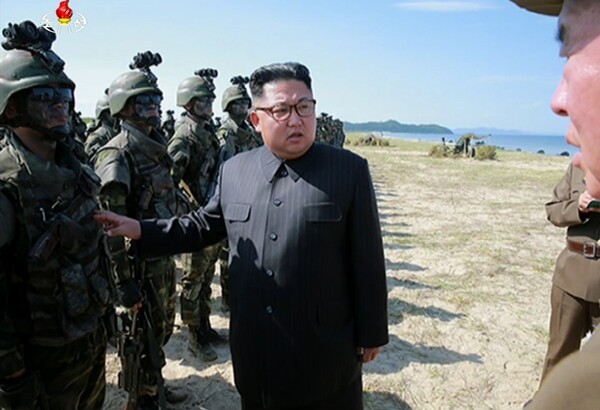hankyoreh
Links to other country sites 다른 나라 사이트 링크
North Korea fires three ballistic missiles into East Sea

North Korea launched three short-range ballistic missiles on Aug. 26. Although they continue to display confrontational behavior through intercontinental ballistic missile (ICBM) tests, it appears North Korean military officials are being just threatening enough to preserve an air of tension. The South Korean government viewed the launch as a routine exercise, and advised against overreacting.
The missiles were launched from Gitdaeryung base just south of Wonsan, Gangwon Province. According to South Korea's Joint Chiefs of Staff, two of them traveled 250 kilometers off the coast and fell into the East Sea, while one of the rockets exploded immediately after the launch. They were assessed to be either short-range missiles or rockets. This was nearly a month after the launch of the ICBM Hwaseong-14 on July 28.
The launch occurred during the Korea-US Ulchi Freedom Guardian joint military exercises, which are taking place from Aug. 21-31st. North Korea has customarily responded to the Ulchi exercises with missile launches. A senior Blue House official called it a "typical North Korean response," and advised against overreacting.
Although the Blue House called for a closed-door meeting of the National Security Council, no public statements were made. Even the Ministry of Foreign Affairs, which usually issues a statement of reproach after North Korean ballistic missile launches, made no announcements. Simply put, the launch did not present enough of a strategic threat to discontinue the current route of applying pressure and sanctions against North Korea while seeking diplomatic channels.
Yet there is a concern that the launch occurred shortly after the US made conciliatory gestures. On Aug. 22, President Trump remarked, "I respect the fact that I believe he [Kim Jong-un] is starting to respect us," and US Secretary of State Rex Tillerson said it was worth nothing that we "have had no missile launches or provocative acts on the part of North Korea" in recent days. Some observers view the recent launch as a response to the US rhetoric. Basically, North Korea will not quietly follow the dialogue roadmap that the US has laid out. Yet there is a noticeable level of restraint, as the missiles did not leave the surrounding territory of the Korean Peninsula.
Conflicting initial interpretations among Korean and US authorities concerning the launch created a bit of controversy. The Blue House reported it as a "modified 300-millimeter rocket launcher," while the US Pacific Command identified it as a "short-range ballistic missile launch." A 300-millimeter launcher is a multiple rocket launcher (MRL). The South Korean military has a 230-mm MRL known as "Cheonmu." MRLs and ballistic missile systems are both rocket propulsion units. However, MRLs can fire more than ten rockets simultaneously, and are used to neutralize an entire region, while ballistic missiles are controlled by a guidance system to hit a specific target.
To quell the controversy, a Joint Chief of Staffs official made a conciliatory announcement that the projectile had not been "conclusively identified as a 300-mm rocket launcher," and that "extensive analyses" were still being conducted. He added that it's "difficult to differentiate between rocket launchers and ballistic missiles" from their flight path on radar systems, insisting that the initial analysis of such situations are always followed by more extensive analyses.
By Park Byong-su, senior staff writer, and Kim Bo-hyup and Lee Jung-ae, staff reporters
Please direct questions or comments to [english@hani.co.kr]

Editorial・opinion
![[Guest essay] The real reason Korea’s new right wants to dub Rhee a founding father [Guest essay] The real reason Korea’s new right wants to dub Rhee a founding father](https://flexible.img.hani.co.kr/flexible/normal/500/300/imgdb/original/2024/0423/8317138574257878.jpg) [Guest essay] The real reason Korea’s new right wants to dub Rhee a founding father
[Guest essay] The real reason Korea’s new right wants to dub Rhee a founding father![[Column] ‘Choson’: Is it time we start referring to N. Korea in its own terms? [Column] ‘Choson’: Is it time we start referring to N. Korea in its own terms?](https://flexible.img.hani.co.kr/flexible/normal/500/300/imgdb/original/2024/0423/3617138579390322.jpg) [Column] ‘Choson’: Is it time we start referring to N. Korea in its own terms?
[Column] ‘Choson’: Is it time we start referring to N. Korea in its own terms?- [Editorial] Japan’s rewriting of history with Korea has gone too far
- [Column] The president’s questionable capacity for dialogue
- [Column] Are chaebol firms just pizza pies for families to divvy up as they please?
- [Column] Has Korea, too, crossed the Rubicon on China?
- [Correspondent’s column] In Japan’s alliance with US, echoes of its past alliances with UK
- [Editorial] Does Yoon think the Korean public is wrong?
- [Editorial] As it bolsters its alliance with US, Japan must be accountable for past
- [Guest essay] Amending the Constitution is Yoon’s key to leaving office in public’s good graces
Most viewed articles
- 1[Column] ‘Choson’: Is it time we start referring to N. Korea in its own terms?
- 2Senior doctors cut hours, prepare to resign as government refuses to scrap medical reform plan
- 3[Guest essay] The real reason Korea’s new right wants to dub Rhee a founding father
- 4Why Korea shouldn’t welcome Japan’s newly beefed up defense cooperation with US
- 5[Column] The clock is ticking for Korea’s first lady
- 6Opposition calls Yoon’s chief of staff appointment a ‘slap in the face’
- 7New AI-based translation tools make their way into everyday life in Korea
- 8Terry Anderson, AP reporter who informed world of massacre in Gwangju, dies at 76
- 9Korean government’s compromise plan for medical reform swiftly rejected by doctors
- 10[Editorial] Japan’s rewriting of history with Korea has gone too far